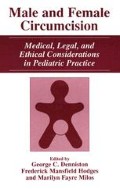Abstract
In 1992, I conducted a series of interviews with physicians in Salt Lake City, Utah. Among other questions, interviewees were asked what knowledge they had of the nature and function of the prepuce. Aside from the ability of a few to recite a passage from a pamphlet produced by the American Academy of Pediatrics (in which the prepuce is described as tissue that protects the glans penis), most physicians were ignorant of the anatomy and physiology of the genital structures they were routinely removing from infants and children. Subsequent research revealed the reason for their lack of knowledge.
Access this chapter
Tax calculation will be finalised at checkout
Purchases are for personal use only
Preview
Unable to display preview. Download preview PDF.
References
American Academy of Pediatrics Newborns: Care of the Uncircumcized [sic] Penis. Evanston: American Academy of Pediatrics 1984.
See: Snell RS. Arlas of Clinical Anatomy. Boston: Little, Brown and Company. 1978:136.
Glenister TW. A consideration of the processes involved in the development of the prepuce in man. Br J Urol 1956;28:243–9.
Hunter RH. Notes on the development of the prepuce. J Anat 1935;70:68–75.
Gairdner D. The fate of the foreskin. BMJ 1949;2:1433–7.
Gairdner D. The fate of the foreskin. BMJ 1949;2:1433–7.
Hunter RH. Notes on the development of the prepuce. J Anat 1935;70:68–75.
Jefferson G. The peripenic muscle: some observations on the anatomy of phimosis. Surgery, Gynecology and Obstetrics 1916;23:177–81.
Woolsey G. Applied Surgical Anatomy. New York: Lea Brothers. 1902:405–7.
Jefferson G. The peripenic muscle: some observations on the anatomy of phimosis. Surgery, Gynecology, and Obstetrics 1916;23:177–81.
Kayaba H, Tamura H, Kitajima S, Fujiwara Y, Kata T, Kata T. Analysis of shape and retractability of the prepuce in 603 Japanese boys. J Urol 1996;156:1813–5.
Hinman F. The blood supply to preputial island flaps. J Urol 1991;145:1232–5.
Juskiewenski S. A study of the arterial blood supply to the penis. Anatomia Clinica 1982;4:101–7.
Winkelman RK. The erogenous zones: their nerve supply and its significance. Proceedings of the Staff Meetings of the Mayo Clinic 1959;34:39–47.
Kaneko S. Penile Electrodiagnosis penile peripheral innervation. Urology 1987;30:210–2.
Winkelmann RK. The cutaneous innervation of human newborn prepuce. J Invest Dermatol 1956;26:53–67.
Winkelman RK. The erogenous zones: their nerve supply and its significance. Proceedings of the Staff Meetings of the Mayo Clinic 1959;34:39–47.
Ohmori D. Über die Entwicklung der Innervation der Genitalapparate als Peripheren Aufnahmeapparat der Genitalen Reflexe. Zeitschrift für Anatomie und Entwicklungsgeschichte 1924;70:347–410.
De Girolano A, Cecio A. Contributo alla conoscenza dell’innervazione sensitiva del prepuzio nell’uomo. Bollettino della Societa Italiana de Biologia Sperimental 1968;44:1521–2.
Winkelmann RK. The cutaneous innervation of human newborn prepuce. J Invest Dermatol 1956;26:53–67.
Bazett HT, McGlone B, Williams RG, Lufkin HM. Depth, distribution and probable identification in the prepuce of sensory end-organs concerned in sensations of temperature; thermometric conductivity. Archives of Neurology and Psychiatry 1932;27:484–515.
Taylor JR, Lockwood AP, Taylor AJ. The prepuce: specialized mucosa of the penis and its loss to circumcision. Br J Urol 1996;77:291–5.
Taylor J. The prepuce: specialized mucosa of the penis and its loss to circumcision. Transcript of Presentation at the Second International Symposium on Circumcision. May 1, 1991.
Taylor JR, Lockwood AP, Taylor AJ. The prepuce: specialized mucosa of the penis and its loss to circumcision. Br J Urol 1996;77:291–5.
Kohler K. Circumcision. In: Jewish Encyclopedia. New York: KTAV Publishing House, Inc. 1964:93.
Austin FD, Sharpe TG. Circumcision. New York Medical Journal 1917;106:787–88
American Academy of Pediatrics. Newborns: Care of the Uncircumcized [sic] Penis. Evanston: American Academy of Pediatrics. 1984.
Halata Z, Munger BL. The neuroanatomical basis for the protopathic sensibility of the human glans penis. Brain Res 1986;371:205–30.
Taylor JR, Lockwood AP, Taylor AJ. The prepuce: specialized mucosa of the penis and its loss to circumcision. Br J Urol 1996;77:291–5.
Taylor JR, Lockwood AP, Taylor AJ. The prepuce: specialized mucosa of the penis and its loss to circumcision. Br J Urol 1996;77291–5.
Werker PM, Terng AS, Kon M.The prepuce free flap: dissection feasibility study and clinical application of a super-thin new flap. Plast Reconstr Surg 1998;102:1075–82.
Editor information
Editors and Affiliations
Rights and permissions
Copyright information
© 1999 Kluwer Academic / Plenum Publishers, New York
About this chapter
Cite this chapter
Scott, S. (1999). The Anatomy and Physiology of the Human Prepuce. In: Denniston, G.C., Hodges, F.M., Milos, M.F. (eds) Male and Female Circumcision. Springer, Boston, MA. https://doi.org/10.1007/978-0-585-39937-9_2
Download citation
DOI: https://doi.org/10.1007/978-0-585-39937-9_2
Publisher Name: Springer, Boston, MA
Print ISBN: 978-0-306-46131-6
Online ISBN: 978-0-585-39937-9
eBook Packages: Springer Book Archive

